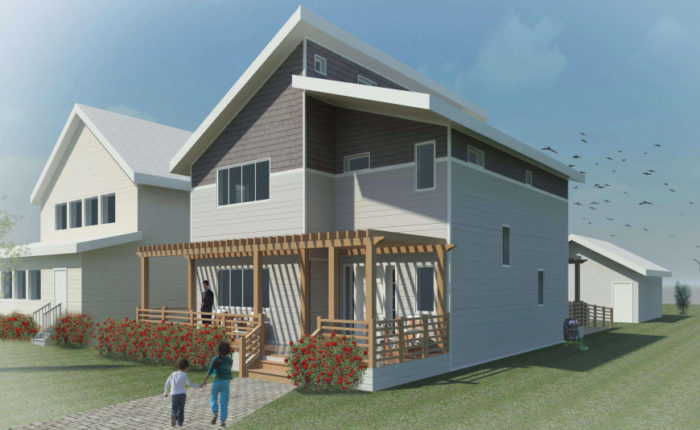
Image Credit: DOE
A team of students from the University of Minnesota came up with the winning entry in this year’s Race to Zero competition with a 2,544-square-foot two-story house designed to be affordable as well as energy-efficient.
The OptiMN Impact Home was designed specifically for infill lots in North Minneapolis and meets both the Department of Energy’s Zero Energy Ready Home criteria and a program established by the city of Minneapolis called Green Homes North. The project was a collaboration between the university and Urban Homeworks, a neighborhood development program in Minneapolis.
According to the DOE, the aim of the competition, now in its second year, is to produce affordable, zero-energy homes that can be built by mainstream builders. The competition drew 33 teams from 27 different universities in Canada and the U.S., with winners announced last month at the National Renewable Energy Laboratory in Golden, Colorado.
DOE has posted a full list of entries and details about the houses at its website.
Housing for a hard-hit part of town
The university team targeted a vacant lot in a section of North Minneapolis that was struck by tornados in 2011 and also affected by the foreclosure crisis a few years earlier, according to a fact sheet distributed by the team. There are many vacant lots in the area where Green Homes North plans to build 100 energy-efficient homes.
The house is designed for a 40-foot-wide lot with its long axis aligned east-to-west, to make the most of solar gain. With most Minneapolis house lots running east-to-west, the team said, the design would be well suited to the area.
Among the features of the winning design are Energy Star appliances and windows, WaterSense low-flow plumbing fixtures, rainwater storage, LED lights, photovoltaic panels, low-VOC paints and finishes, and concrete made with fly ash.
The total finished floor area is 1,696 square feet with another 848 square feet in a lower level that also could be finished. The design includes three bedrooms and 1 1/2 bathroom (plus another in the lower level).
Some of the details:
- Foundation: The slab and footings are insulated to R-10, foundation walls to R-15. Moisture control comes with capillary breaks, a waterproof membrane, perimeter drainage, and a sealed sump.
- Exterior walls: The 2×4 stud walls are sheathed with Zip System sheathing, insulated between the studs with fiberglass batts, and insulated on the outside with 3 inches of extruded polystyrene insulation, for a total R-value of R-32.
- Windows: Double-pane, low-e units with a U-factor of 0.27 and a solar heat gain coefficient of 0.20.
- Roof: Vented truss construction with a clerestory; insulated to R-53 with a combination of rigid polyisocyanurate and fiberglass batts.
- Mechanicals: For combined space and water heating, a Polaris condensing water heater plus a SEER 14 air-source heat pump. Heating and cooling distribution via forced-air ductwork.
- Whole-house ventilation: Venmar energy-recovery ventilator.
- Photovoltaic system: Twenty 410-watt PV panels for a total rated capacity of 8.2 kW, with an estimated annual output of 10,337 kWh. With PV, the house has a HERS score of 0.
Students estimated that the house would cost $226,797 to build, well within reach for a family of four with a median income of about $64,000.
Weekly Newsletter
Get building science and energy efficiency advice, plus special offers, in your inbox.














One Comment
Well done. XPS?
This is a nice design. It's great that this competition aims for cost effectiveness and good design as well as energy efficiency, and it seems like a good design that balances the different objectives well.
It's a little ironic that this design, using XPS, appears on the same day as an article telling us about how the XPS industry is dragging their feet, opposing efforts to reduce the global warming impact of their product. It's unfortunate that the design criteria for the competition were not broad enough to require considering that impact.
I'm also curious about the choice of low SHGC windows. Was that really the best choice for this climate, or was it driven by the fact that the low-cost window manufacturer chosen doesn't offer a high SHGC option?
Congratulations to the students. The building industry will be improved as people like them go into the field.
Log in or create an account to post a comment.
Sign up Log in